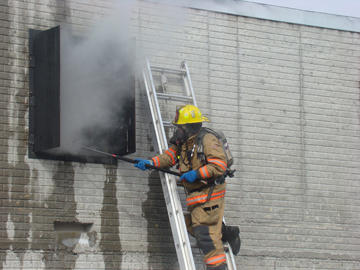Live Fire Experiments Provide Data on the Effects of Fire Resources
Results Could Help Local Governments Make Informed Resource Decisions

During one of the fire safety experiments, a firefighter ventilates the building to let smoke and heat out to improve conditions inside.
ROCKVILLE, Md.—At a live demonstration of fire safety experiments today, a group of firefighting, public safety and scientific organizations described a landmark collaborative study examining the effect of firefighting crew sizes and equipment arrival times on fire growth rates and a person's ability to survive in a structure-related building fire. Funded by the U.S. Department of Homeland Security (DHS), this firefighter safety and resource deployment study will help governments make informed decisions to better match resources with risks to the public and firefighters in their communities.
"This is a study many fire industry leaders have dreamed of for several years," says Chief Dennis Compton of the International Fire Service Training Association, a technical advisor to the project. "Until now, it has simply not been possible, due to the complexity of the tasks proposed and the costs involved."
A broad coalition is participating in the study, including (in alphabetical order): Center for Public Safety Excellence; Commerce Department's National Institute of Standards and Technology (NIST); Fairfax County (Va.) Fire and Rescue Department; International Association of Fire Chiefs; International Association of Fire Fighters; Montgomery County (Md.) Fire and Rescue Service; Urban Institute; and Worcester Polytechnic Institute. DHS has provided $1 million each for the two years of research through the Federal Emergency Management Agency's Assistance to Firefighters Grant Program.
Fire is a costly problem in our communities in both lives and property. According to the National Fire Protection Association, in 2007 there were 530,500 structure fires that killed 3,000 civilians and injured more than 15,000, while causing $10.6 billion in property damage. About 100 firefighters die in the United States each year, with 9/11 being the exception, and many more are injured.
Predicting the effects of changes to fire service resources is critical to fire service and local government leaders. "Currently local governments rely on trial and error or a qualitative basis," explains NIST researcher Jason Averill. "When this study is complete, there will be objective data on which to base these important decisions."
The study focuses on the effects of crew size (two, three, four and five persons per fire engine) and apparatus arrival time (all engines/trucks arrive close together or arrive at longer intervals) on the fire conditions within one 2,000-square-foot, two-story home specially built to survive multiple fire conditions. This "burn house" has been instrumented with state-of-the-art equipment to monitor the interior temperatures and toxic gas build-up within the structure. In addition, researchers will monitor 22 different tasks at the firefighting site, or "fireground."
"NIST has a long history of working with the fire service, and these experiments continue this important tradition," says Shyam Sunder, director of NIST's Building and Fire Research Laboratory. "With NIST's expertise in measurement science, we aim to deliver reliable, accurate and timely data that local governments can use to maximize fire safety in their communities consistent with the risks that they face."
"The information gained from this study will have an immediate and direct impact on how we respond to fires and other emergencies in our communities. Not only will this study provide scientific data to help local government decision makers with establishing an effective firefighting force, resource allocation and community risk assessment, it will furnish fire and emergency service leaders with the tools for a more efficient response to fire and EMS emergencies," says Montgomery County Fire and Rescue Service Acting Fire Chief Richard Bowers. "This study will help make our businesses and communities safer places to live, work and enjoy."
The results from these fireground experiments will complement a fire incident survey involving 400 fire departments from across the country. Together, these two parts of the study will provide an overview of the incident outcomes, along with a detailed understanding of fireground effectiveness. If a third year of funding is awarded, the researchers will develop and validate a computer model that will allow local government decision makers to conduct "what if" analyses in order to help them make informed choices about the deployment of resources for public and firefighter safety.
"The International Association of Fire Chiefs views this study as critical to our assessment of community risks and resources in tough economic times," says Mark Light, CAE, executive director of the International Association of Fire Chiefs. "The outcomes of this study will give fire and emergency service leaders an important new tool as we determine resource allocation."
A full report is expected to be available in fall 2009.
About 50 firefighters from Montgomery County, Md., and Fairfax County, Va. participated each day in the experiments on the fireground at the Montgomery County Fire Rescue Training Center in Rockville, Md.
"The data provided by this multi-agency initiative will help stem the tide of firefighter deaths and make the general public safer," said Chief Ronald L. Mastin of the Fairfax County Fire and Rescue Department. "Our firefighters are privileged and honored to participate in this effort."
As an agency of the U.S. Department of Commerce, NIST promotes U.S. innovation and industrial competitiveness by advancing measurement science, standards and technology in ways that enhance economic security and improve our quality of life.

